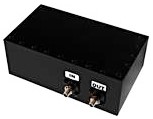Anatech Electronics Newsletter - April 2016 |
|
Anatech Electronics, a manufacturer of RF and microwave filters, has published its April 2016 newsletter. As always, it includes both company news and some tidbits about relevant industry happenings. This month, Sam Benzacar discusses the significantly higher level of RF interference that is inevitable with the coming 5G networks and the expected increase in noise levels. Sam refers to 5G as "the most significant change to the wireless industry since Dr. Martin Cooper made the first cellular phone call," because of opening of spectrum beyond the current 3 GHz region - up to as high as 60 GHz! Anatech's business is to make certain that system and circuit designers have capable filters available to assure successful implementation. 5G, and Interference, Coming in 2020
If you've been following 5G in the media you've no doubt noticed a dramatic increase in coverage that began just before Mobile World Cup Congress in February. It's almost like 5G was just around the corner rather than five years away, but if you dig into the details, it's not hard to see why the flag-waving is starting now. No matter how you measure it, the fifth generation of cellular technology promises to be the most significant change to the wireless industry since Dr. Martin Cooper made the first cellular phone call. It's essentially an almost complete revision of the way networks are constructed, the devices to which they'll connect, the speeds at which they will operate, and a massive reduction in round-trip latency to less than 1 ms that seems to defy the laws of physics. Of course, as Anatech Electronics manufactures RF and microwave filters and filter-related products, we naturally tend to look at new wireless technologies, markets, and frequency allocations from the perspective of interference. And as 5G will dramatically expand the frequencies at which networks will operate from currently just below 3 GHz to various points in the spectrum all the way to 60 GHz, the issue of interference will take on an entirely new persona. The challenge is not designing and manufacturing filters exhibiting exceptional interference rejection and other performance metrics at very high frequencies well into the millimeter-wave region. Anatech Electronics and other filter manufacturers have been effectively addressing them in point-to-point-microwave links, satellite communications, and defense applications for many years. The real problem is that unlike its predecessors, 5G ambitiously aims to connect every type of device that could be connected by wireless means. This includes devices from the usual smartphones and tablets to the man-to-machine and machine-to-machine devices that fall into the category of the Internet of Things, as well as robots, autonomous vehicles, and many other systems. It will essentially attempt to act as a form of aggregator for the various wireless standards that today feverishly compete for supremacy in the IOT arena, a fight that continues to impede the growth of this potentially massive market. With so many different types of systems and so many frequencies to address, the severity of interference that they will cause will only show its face once the first 5G networks are deployed. However, like all other forms of wireless communications, interference is inevitable. So if you're currently in the early stages of designing subsystems or systems that will ultimately be used in 5G, it's definitely not too soon to begin thinking about interference and how you'll solve it. Over more than a quarter of a century, Anatech Electronics has found solutions for thousands of different interference problems in both new designs and those already in the field. So if you're having interference problems—or anticipate them—you're first call should be to us, at (973) 772-4242. Or send us an email to sales@anatechelectronics.com. What's News The Army Materiel Command's Communications-Electronics Research, Development and Engineering Center (CERDEC) is developing a tunable, noise-encrypted radar waveform called Advanced Pulse Compression Noise (APCN) designed to allow radar to function in both contested and congested electromagnetic environments. The APCN waveform is encrypted and can be programmed in real-time to allow the user to optimize radar performance based on the particular scenario. It may also wind up being used by law enforcement as the ability to transmit a radar waveform continuously changing and never repeats itself and looks like noise will be a major challenge for radar detectors. Next: Airborne IEDs According to the US Central Command, terrorists have found a way to create flying Radio-Controlled Improvised Explosive Devices (RC-IEDs), posing yet another challenge for warfighters already challenged by traditional IED attacks that have actually been increasing in recent years. In Iraq alone, more than 11,500 IED attacks occurred last year causing 35,000 casualties, and in Afghanistan there were 8,000 more causing 12,000 casualties, and in Syria causing 5,400 casualties. Owing to the wide availability of quadcopters that can carry significant payloads and can be operated in non-line of site conditions, these threats could be extremely difficult to counter. They can also fly at very low altitudes which makes them extremely hard to detect. Achieving flying IEDs is apparently not beyond the means of increasingly sophisticated terrorist organizations that have created a global supply chain for all of the chemicals and other components required for IEDs.
Volvo's 2017 models will be the first to eliminate the need for a key. Owners will instead will use a smartphone app to unlock and start the engine using a Bluetooth connection between the car and phone. When the driver gets near the car the Bluetooth digital key communicates with it and unlocks it. Authorized users of the car will have the digital key on their phone providing access and it may be possible to locate a parked Volvo as well. GaN RF To Explode The market for gallium nitride (GaN) RF devices will double over the next five years according to the report "GaN RF Devices Market: Applications, Players, Technology, and Substrates 2016 – 2022" from Yole Development, which reports that the total global market for the technology in 2015 was nearly $300 million. The researchers believe that a major uptick will occur beginning in 2019 as 5G networks appear while the total annual growth rate between 2016 at 2022 will be 14%. Wireless infrastructure now represents more than half of the total GaN device market, surpassing defense applications for the first time, according to Yole. Check out Our Filter Products
About Anatech Electronics Anatech Electronics, Inc. (AEI) specializes in the design and manufacture of standard and custom RF and microwave filters and other passive components and subsystems employed in commercial, industrial, and aerospace and applications. Products are available from an operating frequency range of 10 kHz to 30 GHz and include cavity, ceramic, crystal, LC, and surface acoustic wave (SAW), as well as power combiners/dividers, duplexers and diplexers, directional couplers, terminations, attenuators, circulators, EMI filters, and lightning arrestors. The company's custom products and capabilities are available at www.anatechelectronics.com and standard products are available for purchase at the Anatech Electronics integrated Web store https://www.anatechelectronics.com/index.php/webstore Contact: Anatech Electronics, Inc.
Posted April 12, 2016 |

 By Sam Benzacar
By Sam Benzacar Volvo Unveils the Bluetooth-enabled Keyless Car
Volvo Unveils the Bluetooth-enabled Keyless Car

